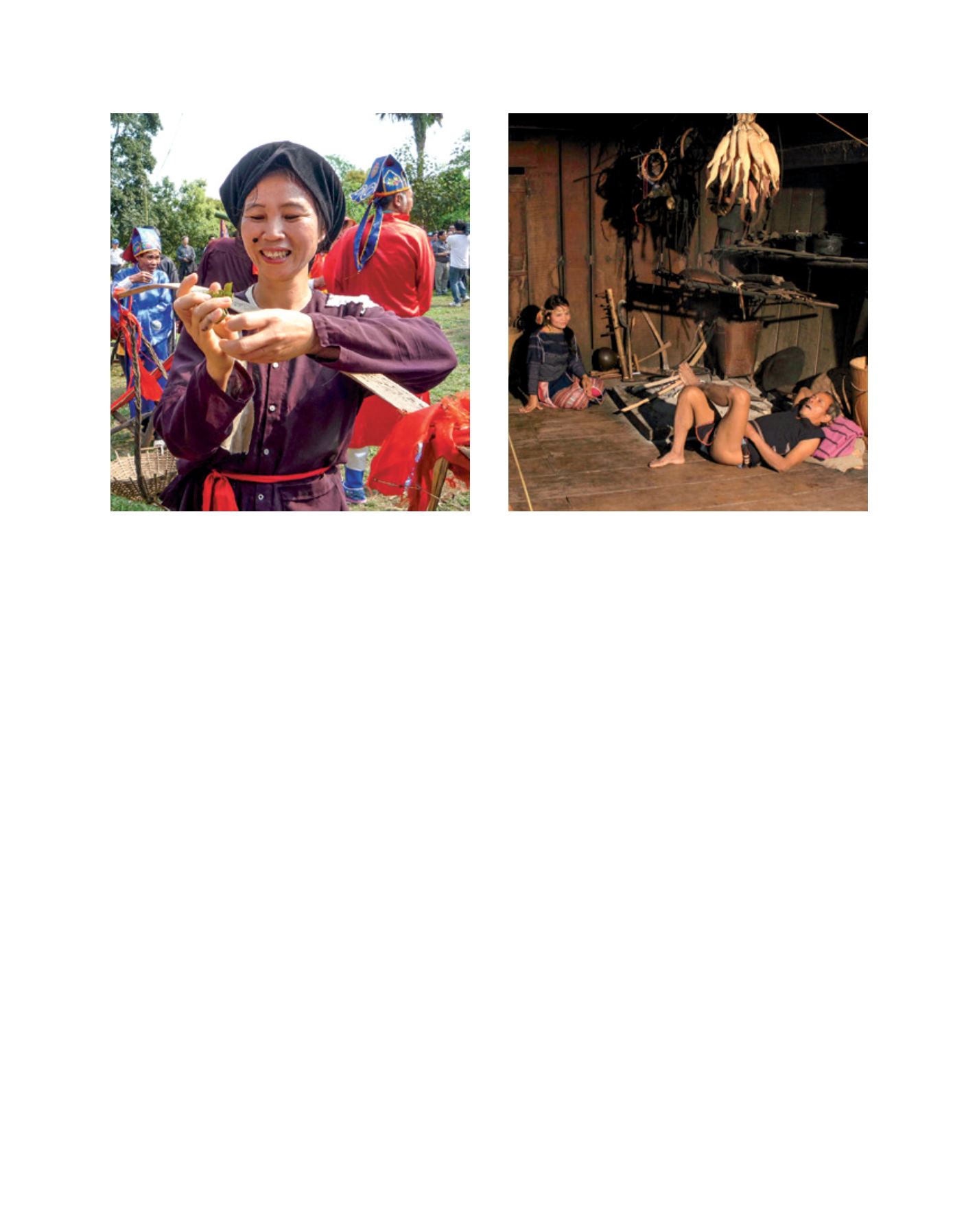

[
] 133
written languages, and most ethnic minority groups have
their own spoken language although they do not have their
own written language. Through written language develop-
ment, the Latin alphabet has been used to create the written
scripts of a number ethnic groups such as the Kinh (as so
called the Viet language), Mong, Rhade, Jarai and so on.
Some other ethnic groups use the ancient scripts that use
Sanskrit, such as the old Cham script, the Thai script, the
Khmer script or the Lu script. Or they use Chinese charac-
ters to recreate their own Sino-Nom languages such as the
old Viet language, the Dao written language, the Giay, the
Tay, the Nung, the San Dui languages and so on. Today, they
use the Sino-Nom scripts to write up religious petitions, or
for religious images or books. Up to now there are about 30
ethnic groups that have their own written language, such as
the Tay, Thai, Chinese, Khmer, Nung, Mon, Jarai, Rhade,
Bahnar, Sedang, Koho, Cham, Hre, Mnong and so on. A
number of the spoken and written languages of ethnic groups
are used in the media such as the Tay, Thai, Dao, Mong,
Jarai, Rhade, Bahnar, Cham and Khmer. Together with the
newspapers in the national language of Viet, the newspaper
agencies at the provincial level have issued their newspapers
in ethnic languages, or they publish the newspapers exclu-
sively for ethnic minority people. The Voice of Viet Nam and
the Television of Viet Nam have their channels in different
ethnic languages such as Mong, Khmer, Rhade, Jarai, Bahnar,
Sedang, Koho, Thai, Cham, Dao and Mnong. Also a number
of provincial television stations air their programmes in the
ethnic languages. Today there are 2,700 schools and classes
in 30 provinces, in which about 140,000 children are taught
in their ethnic languages and which have course books in 12
ethnic languages. Typically, in Soc Trang province the Khmer
language is the teaching language at all elementary schools.
Thus, the ethnic language is a very important tool for educa-
tion and for rapprochement for the country’s development
and to understand the ethnic cultures.
Ethnicity and solidarity occupy an important strategy in
Viet Nam’s policies on culture. The ethnic groups in Viet
Nam are equal, united and they respect and assist each
other in their sustainable development. The governmental
policy is to preserve and promote cultural identities, spoken
and written languages and other cultural expressions of all
ethnic groups. The Government also launched prior poli-
cies in which the cadre and intellectuals of ethnic minorities
have their privilege to get education and training. They will
come back to their homeland to work. The people who work
among the ethnic groups in the remote areas are required to
understand the customs and languages of the ethnic minor-
ities. The understanding and reciprocal knowledge of the
cultural diversity and languages of the ethnic groups in Viet
Nam are clearly identified in the Viet Nam constitution of
2013. Article 5 of the constitution states that:
1. The Socialist Republic of Viet Nam is a unified nation of all
ethnic groups living together in the country of Viet Nam.
2. All the ethnic groups are equal and unite with, respect
and assist one another for mutual development; all acts
of discrimination against and division of the ethnic
groups are prohibited.
3. The national language is the Viet language. Every ethnic
group has the right to use its own spoken and written
language to preserve its own identity and to promote its
fine customs, practices, traditions and culture.
4. The State shall implement a policy of comprehensive
development and create the conditions for the minority
ethnic groups to draw further their internal strengths and
develop together with the country.
A folk performance of the 100 jobs competition at a traditional festival
Image: Dao The Duc
Epic telling among the Bahnar ethnic group in the Central Highlands
Image: Phan Manh Duong
A
gree
to
D
iffer

















